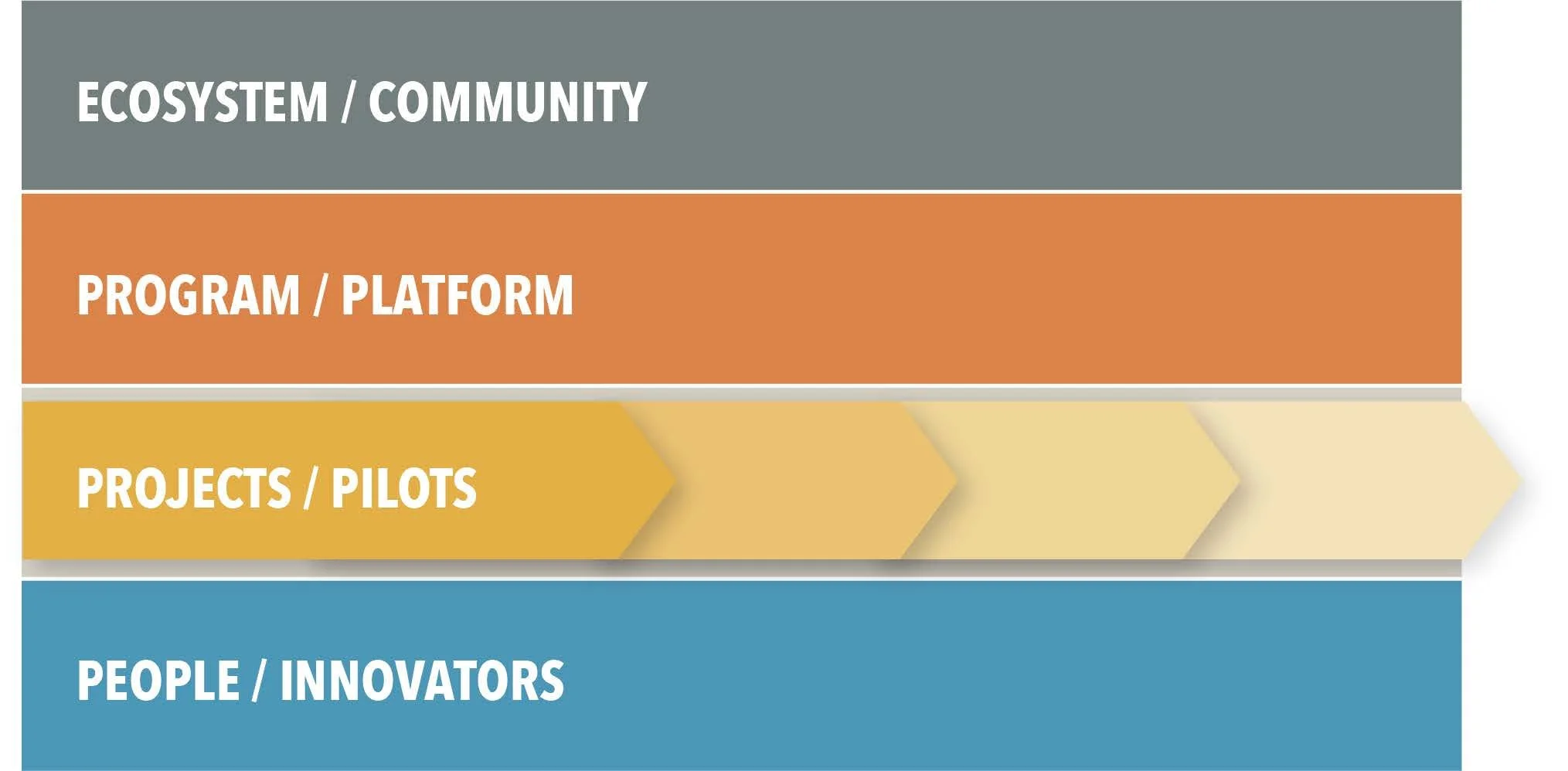Introduction: People are Everything
At the core of every successful innovation process is one key element: people. Innovation isn't just about technology or processes—it begins with empowering individuals to think differently and collaborate effectively. At Orange Sparkle Ball (OSB), we believe that innovation is a human endeavor. Our approach involves identifying the innovators within organizations and empowering them with the tools and support they need to drive meaningful change.
The Innovation Stack: A Roadmap
Our innovation stack provides a framework for thinking about making change. One of our focus areas is People. Identifying key individuals and empowering them to test their ideas in pilots, culminates in actionable projects that generate sustainable results. Every phase of the stack is designed to guide people to think about the resources and structures they need to transform ideas into impact.
PEOPLE ARE KEY TO INNOVATION
Organizations often focus on the end results: new products, systems, or market achievements. However, the journey to those outcomes begins with the people behind the ideas. At Orange Sparkle Ball, we know the most important asset in any innovation process is the people who drive change. These are the people who question current methods, identify opportunities for improvement, and experiment with new approaches.
Our approach centers around empowering individuals and teams to take ownership of innovation. This means giving them the tools, support, and autonomy to explore new ideas, but it also involves creating a culture that nurtures their curiosity and passion.
When we begin any work, our first step is understanding the dynamics within the ecosystem. Who are the key influencers? What motivates them? How can we support their work? This allows us to customize our innovation strategy, ensuring that the people most invested in the outcome drive that strategy.
Case Study: Empowering Public Health Innovators at Rollins
One example of our work of empowering innovators is the Rollins Innovation Summit. We partnered with the Rollins School of Public Health at Emory University to help train public health professionals in the applied skills needed to innovate public health solutions within their organizations for social good and business growth. The result? A program that empirically improved participants’ ability to innovate.
Similarly, key in the innovation stack, is the people—the innovators—who drive change. These individuals may already exist within an organization, but understanding their role and how they interact with others is crucial. Just like participants at the summit worked through our approach, guided by peers, graduate students, and our team of innovation experts to figure out how they leverage their skills to drive innovation, we do the same in organizations by assessing relationships, collaboration dynamics, and the readiness of people to embrace innovation. By understanding these internal connections and identifying influencers, we ensure that the right people are positioned to lead and sustain innovation efforts.
Creating a Ecosystem of Innovation
For innovation to be sustainable, it has to be embedded in organizational culture. We’ve found that the most successful organizations are those where innovation is everyone’s job—not just the R&D team or upper management. When individuals across all levels are encouraged to think creatively, problem-solve, and collaborate, the innovation process becomes more organic and continuous.
At Orange Sparkle Ball, we help organizations create this culture by:
Building Innovation Teams:
We identify and empower key innovators within the organization, providing them with the skills and resources needed to drive change.
Providing Ongoing Support:
Innovation isn’t a one-time event. We create programs that support long-term creative thinking, from continuous professional development to idea-sharing platforms.
Encouraging Collaboration:
Silos can stifle innovation. By bringing together people from different areas, we ensure that diverse perspectives and ideas are shared across the organization. The important thing to remember is that anyone can foster a culture of innovation. Some best practices include:
Recognize that there will be mistakes. Part of the key to fostering an innovative culture is recognizing that not every idea will be adopted and even fewer will succeed after implementation. However, when people feel empowered to keep proposing ideas without fear of retribution or blowback, over time some of the best ideas will emerge from unexpected sources.
Empower people to run with ideas. Consistent with our philosophy that people are at the heart of any idea, the best innovation cultures empower people to carry new ideas as far as they can. The result is an emergent idea ecosystem that is dynamic and constantly evolving in reaction to new information and anticipation of new opportunities.
Lean into people's strengths. Leaning into people's strengths means identifying what each team member does best and aligning their roles with those strengths. This not only boosts individual confidence and engagement but also fosters a collaborative environment where diverse talents drive innovation forward. Here at OSB, we make a point of this internally, and find that doing so in our project execution, and ecosystem building leads to the best results.
Remember, ultimately, that creating: a culture where innovation thrives doesn’t happen overnight, but it’s not impossible either. Start small: build a team of innovators, encourage collaboration across departments, and create a system where new ideas can be shared. What can you do this week to get started?
Conclusion: People as the Catalyst for Change
Our innovation stack focuses on people because, without empowered innovators, there is no change. By focusing on fostering creativity, collaboration, and leadership within an organization, you empower people. And supported innovators is a key component that drives projects, programs, and ecosystems.
Odiraa Okala, Innovation Strategist






